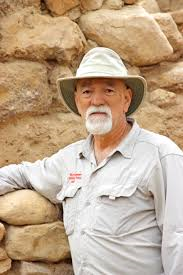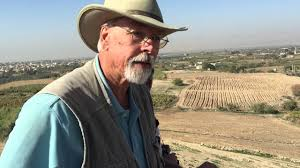Sodom annihilated by meteoritic blast
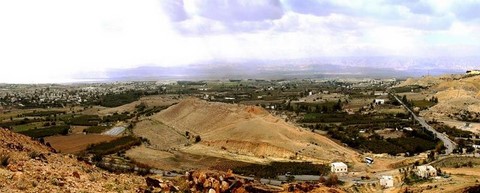
In 1908, a massive blast near Siberia’s Stony Tunguska River flattened some 2,000 square kilometers of uninhabited taiga forestry. Curiously, no crater was discovered and scientists explain the strange phenomena through a meteor explosion some 5-10 km above land.*
An interdisciplinary team of archaeologists and scientists are now using the 1908 Tunguska explosion as a model to explain the equally mysterious end to a thriving civilization that lived for at least three thousand year in a plain near the Dead Sea before being catastrophically annihilated.
As reported in Science News, at the recently concluded Denver-based American School of Oriental Research Annual Meeting, director of scientific analysis at Jordan’s Tall el-Hammam Excavation Project Phillip J. Silvia presented a paper: “The 3.7kaBP Middle Ghor Event: Catastrophic Termination of a Bronze Age Civilization” during a session on Environmental Archaeology of the Ancient Near East. According to the paper’s abstract, the scientists discovered evidence of a “high-heat” explosive event north of the Dead Sea that instantaneously “devastated approximately 500 km2.” The explosion would have wiped out all civilization in the affected area, including Middle Bronze Age cities and towns. Silvia told Science News that the blast would have instantly killed the estimated 40,000 to 65,000 people who inhabited Middle Ghor, a 25-kilometer-wide circular plain in Jordan.
Likewise, the fertile soil would have been stripped of nutrients by the high heat, and waves of the Dead Sea’s briny anhydride salts would have — tsunami-like — washed over the surrounding area. At the same time, the explosion’s fallout caused blisteringly hot, strong winds, which deposited a rain of mineral grains, which have been found on pottery at Tall el-Hammam.
Five large sites in the region which have also been excavated offered additional evidence of an immediate end to settlement at the same time of the proposed Tall el-Hammam disaster. According to Science News, radiocarbon dating of organic archaeological evidence has shown that structures’ mud-brick walls “suddenly disappeared around 3,700 years ago, leaving only stone foundations.”
Contemporary potsherds’s glazes apparently experienced temperatures high enough to transform them to glass, “perhaps as hot as the surface of the sun,” Silvia told the news source.
The study was born of a historical riddle: “That the most productive agricultural land in the region, which had supported flourishing civilizations continuously for at least 3,000 years, should suddenly relinquish, then resist, human habitation for such a long period of time has begged investigation,” states the excavation’s website. As listed in the published abstract, Trinity Southwest University’s Silvia was joined by a roster of multi-disciplinary scientists.
The team of scientists from New Mexico Tech, Northern Arizona University, NC State University, Elizabeth City (NC) State University, DePaul University, Trinity Southwest University, the Comet Research Group, and Los Alamos National Laboratories analyzed samples from 12 seasons of Tall el-Hammam excavations to conclude that the most logical explanation for the settlement’s demise was a meteor explosion.
“This paper surveys the multiple lines of evidence that collectively suggest a Tunguskalike, cosmic airburst event that obliterated civilization — including the Middle Bronze Age city-state anchored by Tall el-Hammam — in the Middle Ghor (the 25 km diameter circular plain immediately north of the Dead Sea) ca. 1700 BCE, or 3,700 years before present (3.7kaBP),” write the authors.
“Based upon the archaeological evidence, it took at least 600 years to recover sufficiently from the soil destruction and contamination before civilization could again become established in the eastern Middle Ghor,” they write.
Could this massive disaster offer an explanation for the biblical story of Sodom?
According to a 2013 Biblical Archaeology Review article by TeHEP co-director Dr. Steven Collins, the Tall el-Hammam site is a strong candidate for the biblical city of Sodom due to a multitude of factors. The discovered disaster, and its precise location, which he ties to biblical references of “ha-kikkar” (or idiomatically, the plain). In the article, among other biblical citations, Collins quotes from Genesis 19:24–25: “Then the Lord rained down burning sulfur on Sodom and Gomorrah — from the Lord out of the heavens. Thus He overthrew those cities and the entire plain, including all those living in the cities — and also the vegetation in the land.”
On the ground at the site, Collins witnessed such destruction first-hand. In a vivid description he writes,
“The violent conflagration that ended occupation at Tall el-Hammam produced melted pottery, scorched foundation stones and several feet of ash and destruction debris churned into a dark gray matrix as if in a Cuisinart.”
Could it really be that this destruction, hypothetically caused by the proposed meteor explosion and its catastrophic fallout, are the natural causes of the divine wholesale razing of the city recorded in the Bible?
In a jointly authored paper between Silvia and Collins, “The Civilization-Ending 3.7KYrBP Event: Archaeological Data, Sample Analyses, and Biblical Implications,” the authors write:
“The physical evidence from Tall el-Hammam and neighboring sites exhibit signs of a highly destructive concussive and thermal event that one might expect from what is described in Genesis 19.”
Further based on studies by atomic energy researcher Samuel Gladstone, the authors write that:
“an airburst yield of 10 megatons over the northeast corner of the Dead Sea would be sufficient to produce the physical damage observed 10 km away at Tall el-Hammam. Note that this is only one-half the yield of the Tunguska airburst event (in Siberia), well within ‘recent’ human experience for meteoritic airbursts!”
“The destruction not only of Tall el-Hammam (Sodom), but also its neighbors (Gomorrah and the other cities of the plain) was most likely caused by a meteoritic airburst event,” the authors conclude.
In his Biblical Archaeology Review article, Collins writes that the massive disaster was seared into collective cultural memory and preserved in the biblical tradition.
“The memory of the destruction of ha-kikkar, with its large population and extensive agricultural lands, was preserved in the Book of Genesis and ultimately incorporated into a traditional tale that, drawing on the layer of ash that covered the destruction of one of its major cities, remembered a place consumed by a fiery catastrophe from ‘out of the heavens’ (Genesis 19:24),” he writes. “The Bible gives the city’s name: Sodom.”
Amanda Borshel-Dan
The Times of Israel, November 22, 2018
* Q-MAG.org remarks: although in the Tunguska event 80 million trees were felled in one snuff, it was not a high temperature event: the trees did not burn, and as far as we know, there were no melted or glazed minerals found on the site.
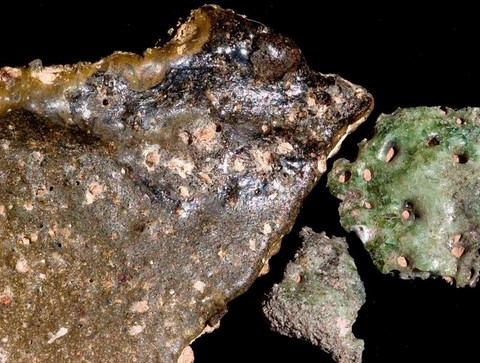
Melted pottery sherd (left), found at Tall el-Hammam, and ‘trinitite’ pieces (right) from ground zero of the Trinity site near Alamogordo. (The term ‘trinitite’ was the name given to a substance left on the desert floor near Alamogordo, New Mexico, after the explosion of the Trinity nuclear bomb on July 16, 1945). Courtesy Mike Luddeni
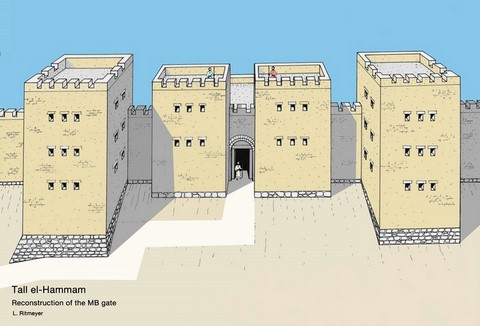
Tall el-Hammam - Sodom - city gate (drawing by Leen Ritmeyer)
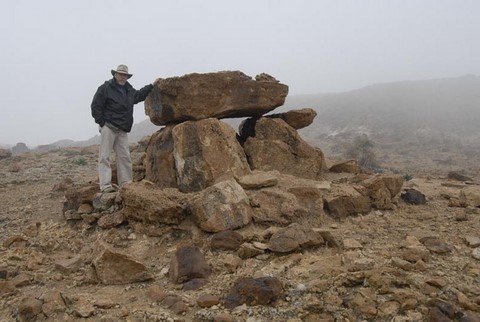
Tall el-Hammam, which had been settled for some 3,000 years before it was annihilated, is situated in surroundings replete with megaliths, comprising several hundred dolmen. (See: Q-MAG.org: In which direction did megaliths spread?
Read also: Making the case for Sodom
An earlier (2014) article on Tall al-Ammam in Popular Archaeology. (Recommended)



